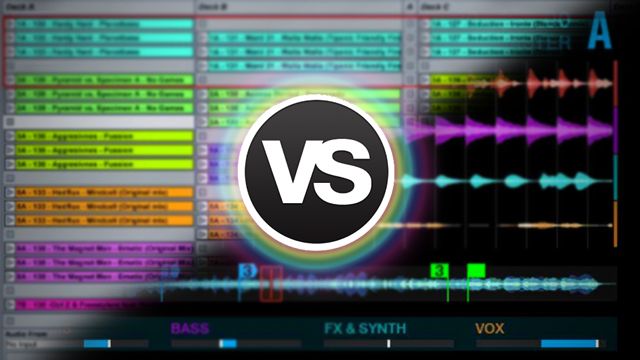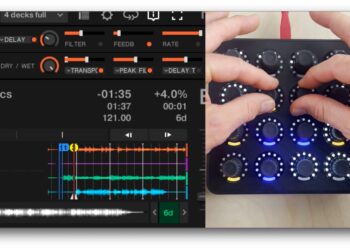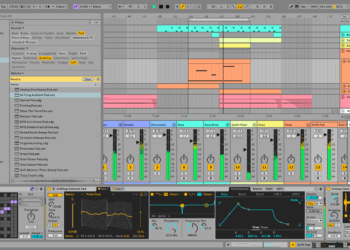Look out Ableton, Traktor might take your job soon. As teased in yesterday’s video, Native Instruments new stems format is set to drop very soon, and many have asked if DJs will embrace the format. Perhaps, but a different group of people might embrace the technology: live performers. Will Ableton Live see an unexpected competitor to its platform? We think it’s a strong possibility.
Will Traktor Stems Change How Live Producers Perform?
Watch our recent interview with Stimming, a 100% live performer, who plays with Ableton and a few extra hardware pieces. Stimming exclusively plays his own material that has been separated into parts. Many live performers that play shows this way come to the same conclusions and break their live sets into 3-4 parts. Here are the common threads:
- Usually an original song is isolated, bounced, and played back in groupings (commonly bass, drums, synths, vocals)
- Groupings are then remixed, solo’d, and effected on the fly.
- The original composition is respected, but allowing a significant degree of creative freedom.
Sound familiar? The Stems format that Native Instruments has developed completely addresses these needs and others quite well.
All live producers almost always add additional improvised elements on top. Usually these are drum patterns, synths or effects. Although some run software synths as plug-ins, and would require a DAW, many prefer external hardware. For them, it might not only be feasible – but possibly even preferential to use Traktor over Ableton for live performances. Let’s break it down
Pros: Why Use Traktor Stems For Live Performances
Convenience of File Management

File size and browsing capacity are huge issues with preparing sets in Ableton Live, which works best with WAV files and lacks any real music library management aside from your own file structure. In short, Live sets are:
- tedious to create
- very large in file size
- difficult to change out on the fly
This makes Traktor a significantly more useful tool when improvisation is needed. Admittedly, if you only have 15 songs in a Live set, this is really not an issue, but Traktor’s ability to seamlessly and quickly float from original material to DJ sets could be very appealing.
To load a “song” broken into 4 parts into Live is also more problematic, while the Stems format conveniently packages everything into one nice file that is easy to load every time.
Preparation Time

Loops and Cue points – essential for live performance – are significantly easier to use and more friendly in Traktor. They also take up a LOT less time to set up. Ableton requires chopping up the song into parts as the core concept of cue points does not exist, and the loop functionality is primitive at best. For producers working with a lot of material (especially >50 songs), they might spend a lot less time managing their music in a more friendly platform like Traktor.
The Mastering Paradigm
In theory, Stems has solved a fundamental live performance challenge. When the original track was created, it was sent out to a high quality mastering engineer, and the process can never be recreated. How then do we manage to have the track hit and punch in the same way when broken up for live use? By blending between the mastered version and individual parts Stems promises to potentially solve this issue.
On the other hand Ableton has the upper hand in this regard supporting native loading of mastering plug-ins that could do the heavy lifting and get the live show nearly there.
Mapping Paradise

Traktor’s strong suit is most certainly the flexibility in which you can take control over the software. It’s a live performers dream interface, allowing for complex interaction experiences and detailed interfaces. While Max 4 Live users can tap into some pretty crazy potential with MIDI, the core mapping functionality is better in Traktor than Ableton.
Cons: Why Traktor Might Not Beat Ableton
A True DAW = Better For Designing Instruments

You can’t beat being able to design instrument racks, drum machines, and complex digital routing when adding live elements to an original performance. Traktor will never become a DAW, and until the dream integration of Machine occurs it will never offer integrated production tools.
Custom FX Racks

For many producers and live performers, their FX racks and routing IS their sound. Utilizing stock Traktor effects is just not going to cut it. It would not be hard to roll out custom effects chains for Native Instruments – it’s obviously deep in their pedigree, but a near-term priority? Probably not.
Traktor vs Ableton For Live Performers: The Bottom Line
I don’t remain convinced that DJs will actually start to play multi-track files any time soon. While the idea sounds intriguing, the format introduces additional mental overhead to an already complex job. However, for live performers, who play the same material every night and need track isolation- Stems + performance DJ software may just give them a new choice in platforms.
If you are considering putting together a live show that involves blending between original material and some basic isolation of parts then Stems might be a very viable option. For those that use analogue hardware Traktor syncs up very well with drum machines like the Roland Tr8.









